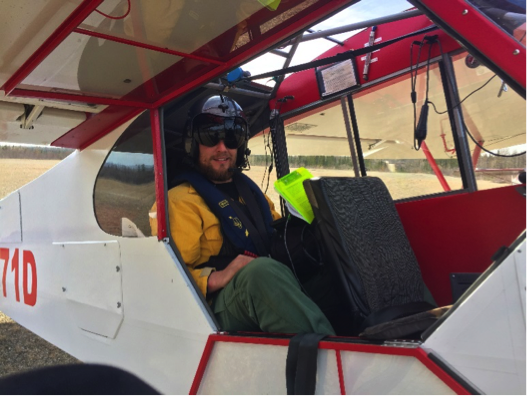As part of the National Park Service’s mission they seek to preserve natural resources for future generations. Monitoring trends in predator populations is vital to recognizing and mitigating any new or persistent threats. In the remote parks of northern Alaska, Wildlife Conservation Society’s Arctic Beringia program is supporting NPS with aerial surveys.
I recently took part in an aerial brown bear survey conducted by the National Park Service and the Alaska Department of Fish and Game in Noatak National Preserve and Gates of the Arctic National Park. I flew in a Supercub airplane (Photo 2) and looked for bears in specific survey units. Most of the survey area was mountainous or open habitat without trees. Bear densities in the northwest arctic are generally lower than in other areas of Alaska and the rate of detection of any given bear is low. To get precise estimates of bear detection and get a more accurate population estimate, we used double sampling photo mark-recapture method. In this method, a pilot-observer team in one plane flies a survey unit and takes locations and photos of bears and shortly thereafter a second pilot-observer team flies the same unit and takes locations and photos of bears. This method allows us to estimate the total population of bears including the bears that neither team observed. This also creates a friendly competition between teams about who saw which bears!

A mating pair of brown bears in Gates of the Arctic National Park. Photo Credit: Dylan Schertz
At the end of each day, pilot-observer teams compared photos and locations of the bears they saw to uniquely identify individual bears and bear groups. High quality photos are required so the teams can tell whether or not they saw the same bears. As an observer it was my job not only to collect location, activity, habitat, weather, and group size information about the bears we saw, but also to take photos of the bears. In order to get a quality photo the pilot would set me up for another pass over the bear to get the right angle and lighting. I would wrap the camera strap around my arm, open the side window of the plane, and stick my lens out the window while the pilot turned the plane over the bear.

Returning from a day of surveying, I will be happy to be able to stretch my legs again. Photo Credit: Jesse Cummings
Most people would not enjoy spending 8 hours wedged in the back seat of a small two-seater plane with only one break to get out and stretch and answer any calls of nature! However, the striking views in the upper Noatak River drainage make us all eager to get back in the aircraft.

Breathtaking views on the flight out to the survey plots. Photo Credit: Dylan Schertz
In addition to the spectacular mountain views, seeing bear cubs fresh out of their den is absolutely amazing. Bears often choose to den on mountain slopes. Shortly after they emerge from their dens bears move out of mountainous areas into lower elevations as the spring and summer progress following the availability of seasonal foods. Females with cubs may remain in mountainous areas longer than other bears to spatially separate themselves and thereby protect their young.

A sow with three cubs of the year in Noatak National Preserve. Photo Credit: Dylan Schertz
Brown bears are a Vital Sign of the National Park Service’s Arctic Network (ARCN) Inventory and Monitoring Program. Brown bears were chosen as a Vital Sign to monitor for several reasons: they are sensitive to habitat fragmentation and habitat loss, human development directly affects their survival, and because they are an “umbrella species.” Umbrella species are species that use a broad range of habitats and require large areas of habitat so their conservation confers protection to other co-occurring species with smaller spatial habitat requirements. The data from this aerial survey and others like it in other ARCN parks will inform biologists about the abundance and distribution of brown bears. This information will allow park biologists and managers to make informed comments about and decisions regarding park management and State and Federal harvest proposals for brown bears. For more information about the Park Service’s work on bears: https://science.nature.nps.gov/im/units/ARCN/vitalsign.cfm?vsid=18
Written by Dylan Schertz, WCS field technician, July 2017